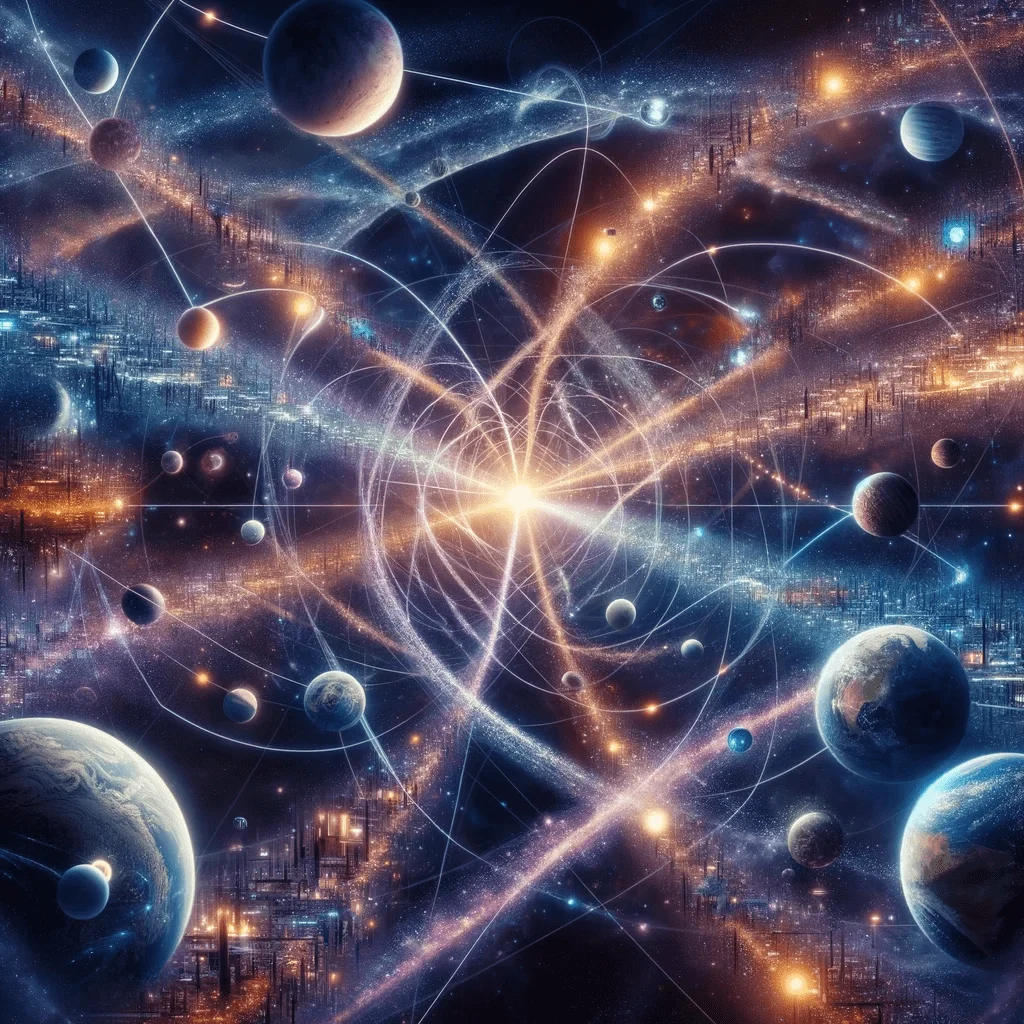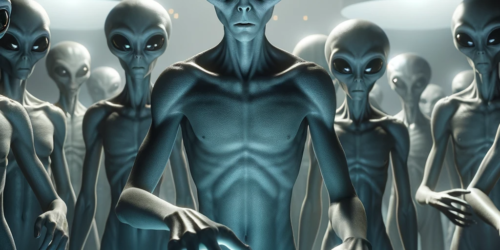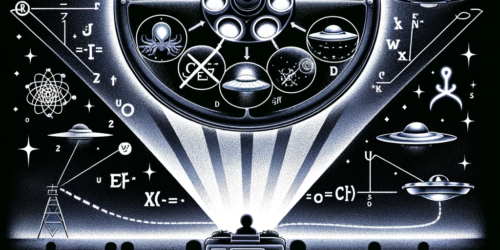Alternate and Parallel Timelines

The concepts of alternate and parallel timelines have long captivated the minds of scientists. These ideas speculate on the existence of multiple realities branching off from each moment, leading to countless universes where every possibility exists.
Hugh Everett III, an American physicist, proposed the Many-Worlds Interpretation (MWI) of quantum mechanics in the 1950s. This interpretation suggests that all possible alternative histories and futures are real, each representing an actual “world” or “universe” within a larger multiverse.
Alternate and parallel timelines refer to theoretical realities that exist concurrently yet separately from our own. Alternate timelines can be seen as divergent paths, stemming from a single event that had different outcomes. Parallel timelines, on the other hand, could be imagined as existing alongside our own, with events that might be similar, completely different, or follow completely different laws of physics.
These concepts are tied to the entirety of time and space and they could have existed since the dawn of the universe, and according to some theories, new timelines might be continually forming.
The why is steeped in the realm of quantum mechanics and the notion of superposition, where particles can exist in multiple states simultaneously until observed. When extrapolated to larger scales, some interpretations suggest that every event might give rise to multiple outcomes, each existing in its own timeline.
- The Many-Worlds Interpretation, as mentioned, suggests that with every quantum event, the universe “splits” into multiple versions, each reflecting a different outcome. It’s considered a mainstream interpretation of quantum mechanics, a field that was recognized with the 2012 Nobel Prize in Physics for groundbreaking experimental methods (Source: Nobel Prize organization).
- Another scientific idea often associated with parallel universes is the concept of cosmic inflation. In this framework, different “bubble universes” might emerge in a larger multiverse, each with potentially different physical laws. This concept was first proposed by cosmologist Alan Guth in the 1980s (Source: Guth, A. H. “Inflationary universe: A possible solution to the horizon and flatness problems,” Physical Review D, 1981).
- The mathematics of string theory, a proposed “theory of everything,” also allows for the existence of multiple dimensions and, potentially, parallel universes (Source: Greene, B. “The Elegant Universe: Superstrings, Hidden Dimensions, and the Quest for the Ultimate Theory,” 1999).
Theoretical physicist Brian Greene, for example, often talks about parallel universes in the context of string theory, noting that while mathematically plausible, empirical evidence is currently lacking. Michio Kaku, another theoretical physicist and popular science communicator, has also discussed these concepts, emphasizing that they’re speculative but not beyond the realm of possibility.
In the realm of nonfiction, Greene’s “The Elegant Universe” explores string theory and its implications for multiple dimensions and universes. Meanwhile, in fiction, Philip K. Dick’s “The Man in the High Castle” imagines an alternate timeline where World War II ended differently, highlighting the rich narrative possibilities of these concepts.
The notion of alternate and parallel timelines, along with their possible connections to phenomena such as déjà vu and the Mandela Effect, offers a captivating lens through which to view reality.
Scientifically, our comprehension of the mechanisms that could permit transitions between timelines or parallel universes is still nascent, yet undeniably intriguing. Quantum mechanics presents compelling concepts like superposition and entanglement, positing that particles can simultaneously inhabit multiple states or influence each other across vast distances instantly. As we continue to explore, it’s entirely plausible that we might uncover similar phenomena operating on larger scales, encompassing human experiences and timelines.
The concept of time travel, while currently restricted by Einstein’s theory of relativity, may yet have undiscovered facets. Theoretical models have proposed phenomena such as wormholes or exotic forms of matter that could circumvent these restrictions and permit time travel, demonstrating the potential for alternate and parallel timelines (Source: Thorne, Kip S. “Black Holes and Time Warps: Einstein’s Outrageous Legacy,” 1994).
Déjà vu, an uncanny sense of reliving a moment, could be more than just a hiccup in our brain’s information processing. Could this experience be an echo from a parallel timeline, a ripple effect from a different version of ourselves in a different reality? While neuroscience offers one perspective, the mystery is far from settled.
The Mandela Effect, a phenomenon where a group collectively remembers events or facts differently from the established reality, is often framed as a testament to the fallibility of memory. Yet, it might also be seen as potential evidence for alternate timelines. Could it be that these shared memories are glimpses into realities where these events did occur?
Novels like “The Time Traveler’s Wife” by Audrey Niffenegger creatively examine the possibilities of parallel and alternate timelines. Non-fiction works, such as “Parallel Worlds” by Michio Kaku, looks into the theoretical physics that could potentially substantiate the existence of parallel universes.
Emerging developments in quantum computing add another layer of intrigue to our exploration of alternate and parallel timelines. Quantum computers operate based on the principles of quantum mechanics, leveraging the phenomena of superposition and entanglement to process information in ways far beyond the capabilities of classical computers. This means they can potentially manipulate and interpret data across multiple states simultaneously, akin to operating across multiple realities at once. This idea is referred to as quantum parallelism, and some posit it’s as if the computer is harnessing the computational power of many parallel universes (Source: David Deutsch, “Quantum theory, the Church–Turing Principle and the universal quantum computer,” Proceedings of the Royal Society of London. A. Mathematical and Physical Sciences, 1985).
Quantum computers are not merely theoretical but do indeed exist and are part of a rapidly evolving field of technology. Different models of quantum computers have been built and operated by research institutions and technology companies around the world.
A quantum computer leverages the principles of quantum mechanics to process information. Unlike classical computers that use bits (binary digits, either 0 or 1) as their smallest units of information, quantum computers use quantum bits, or “qubits.” A qubit can exist in a state of 0, 1, or both at the same time, thanks to a quantum property known as superposition. This allows quantum computers to process a massive number of computations simultaneously.
While alternate and parallel timelines refer to the myriad of possible universes created by different choices and events, the interdimensional hypothesis suggests a way these diverse realities could connect. It’s like considering a vast library of books as alternate timelines or frequencies, each telling a different story, and the interdimensional hypothesis proposes that characters from one book could visit another. Both ideas play with the notion of a vast multiverse, but focus on different angles: the existence of these universes versus the crossing between them.
Therefore, phenomena like the Mandela Effect or UFO sightings could be explained by this crisscrossing and travel between dimensions. This suggests a universe much more interconnected and dynamic than we might have imagined, where historical discrepancies or encounters with the unexplained aren’t merely errors, but windows into the vastness of our multiverse.
While these ideas are at the frontier of our current scientific understanding, they are by no means dismissed outright. The exploration of alternate and parallel timelines, and their potential connections to phenomena like déjà vu or the Mandela Effect, are part of the continuous journey of scientific discovery.



